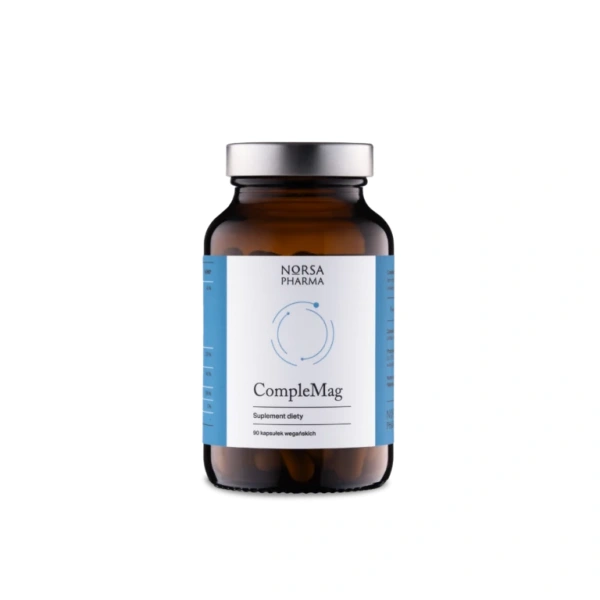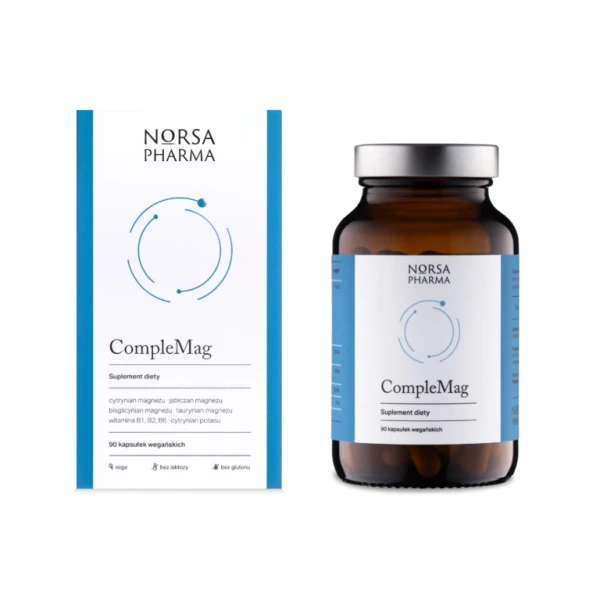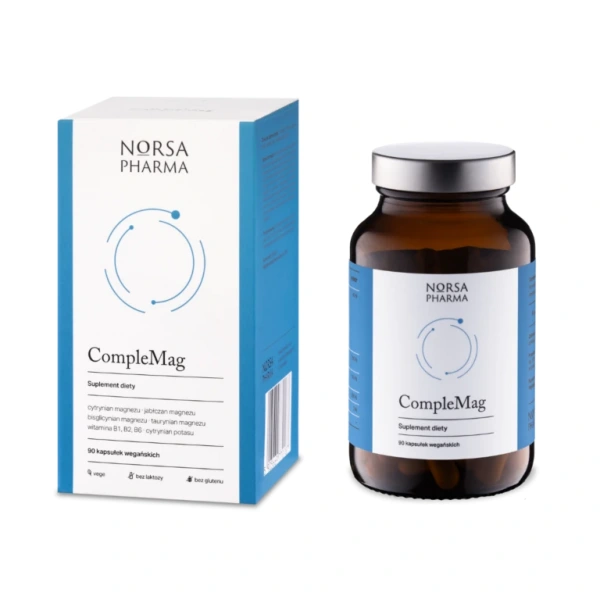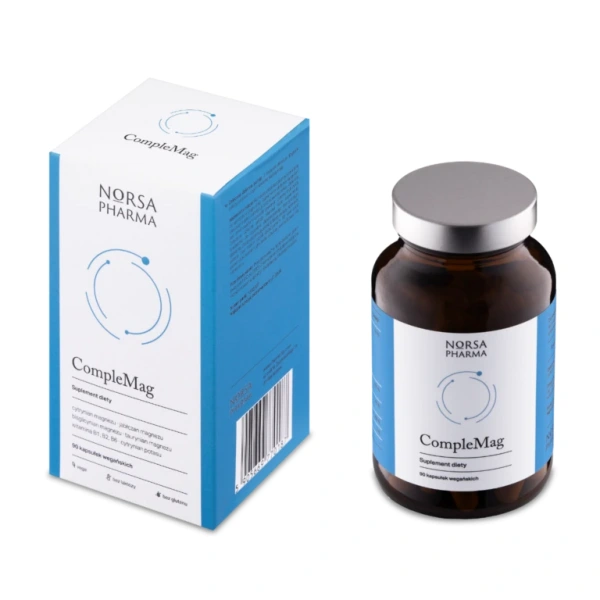- For the home
Health
- Bones and Joints
- Digestion and Healthy GI
- Essential Oils
- Fish Oil / Omega-3
- Healthy Sleep
- Heart and Cardiovascular System
- Immunity
- Liver
- MCT Oil
- Men
- Mind and Focus
- Minerals
- Pet Supplements
- Pro-Health Supplements
- Probiotics
- Senior
- Superfoods
- Urinary Tract
- Vitamins
- Vitamins for hair
- Vitamins for nails
- Vitamins for the skin
- Weight Management
- Woman
Healthy Diet
Herbs
Mother and Baby
Sport
Your Goal
Pet Supplements
Cosmetics
- Cosmetics for children
- Men's Cosmetics
- Unisex Cosmetics
- Women's Cosmetics
- Dezodoranty i perfumy
- Higiena jamy ustnej
- Kosmetyki akcesoria
- Kosmetyki dla dzieci2
- Kosmetyki do ciała
- Kosmetyki do higieny intymnej
- Kosmetyki do opalania
- Kosmetyki do pielęgnacji ust
- Kosmetyki do twarzy
- Kosmetyki do włosów
- Papier toaletowy / chusteczki
NORSA PHARMA CompleMag (magnesium, potassium, B-group vitamins) 90 vegan capsules
Available: 30 szt.
19,10 €
Price per portion: 0,42 €Available: 30 szt.
After purchase you will receive 78 pts
Product Details
- Description
- Dosage
- Ingredients Table
- About the brand
- Nutritional information
- Reviews (0)
- Articles
CompleMag – why is it worth it?
The ingredients contained in CompleMag contribute to1:
- maintaining proper energy metabolism (magnesium, thiamine, riboflavin, vitamin B6)
- reducing the feeling of fatigue and weariness (magnesium, riboflavin, vitamin B6)
- proper functioning of the nervous system (magnesium, thiamine, riboflavin, vitamin B6)
- maintaining proper psychological functions (magnesium, thiamine, vitamin B6)
- maintaining healthy bones (magnesium)
- maintaining electrolyte balance (magnesium)
- CompleMag is four complementary sources of magnesium of organic origin with high bioavailability.
- CompleMag contains only organic magnesium compounds, which are absorbed much better than commonly available inorganic forms. The absorption of the forms of magnesium used in CompleMag reaches up to 90%.2
- CompleMag additionally contains a complex of B vitamins and potassium, which, together with magnesium, participate in many enzymatic reactions.
- CompleMag is an intelligent and holistic solution for people requiring magnesium supplementation.
- Contains no flavor additives, dyes, aromas or sweeteners.
Magnesium taurate – is a chemical form that reaches the nervous system due to the presence of the taurine transport system in the endothelial cells of the capillaries of the blood-brain barrier.3
Magnesium citrate - is characterized by good solubility in an aqueous environment, stability and high absorption, which has been scientifically documented in in vivo studies. Magnesium citrate, compared to other compounds, is the most commonly used chemical form of magnesium, both in short-term and long-term supplementation.4
Magnesium bisglycinate – consists of two glycine molecules covalently bonded to magnesium. This bond is strong enough to prevent magnesium from dissociating in the upper gastrointestinal tract and thus forming complexes with anti-nutrients that inhibit absorption.5
Magnesium malate – a combination of magnesium and malic acid. It is relatively easily digested and may stay in the body longer than other forms of magnesium.6
Vitamin B6 – cooperates with magnesium in many enzyme systems and increases the accumulation of intracellular magnesium.7
Vitamin B2 – takes part in the metabolism of vitamin B6. Improves the conversion pathways of vitamin B6 to its active form.8
Vitamin B1 – Thiamine and magnesium are closely related biochemically, as magnesium participates directly or indirectly in the action of many thiamine-dependent enzymes. Magnesium is required to convert dietary vitamin B1 into the active form thiamine pyrophosphate (TPP), which participates in enzymatic functions related to the metabolism of carbohydrates, branched-chain amino acids and fatty acids.9,10
Potassium – together with magnesium, are the two most abundant intracellular cations in the body. 11 They play an important role in the functioning of excitable tissues, such as nerves, skeletal muscles and heart muscle. 12 They also play key roles in many other important biological processes, such as cellular energy metabolism, cell replication, and protein synthesis.13,14
1. Scientific Opinion on the substance of health claims related to magnesium. EFSA Journal;2010, 8(10):1807.
2. Iskra, M., Krasińska, B., & Tykarski, A. (2013). Magnesium—physiological role, clinical importance of deficiency in hypertension and related diseases, and possibility of supplementation in the human body. Arterial Hypertension, 17(6), 447-459.
3. Diana Fiorentini et al. Magnesium: Biochemistry, Nutrition, Detection, and Social Impact of Diseases Linked to Its Deficiency. Nutrients 2021, 13(4), 1136; https://doi.org/10.3390/nu13041136.
4. Maria Iskra I co. Magnesium — physiological role, clinical importance of deficiency in hypertension and related diseases, and possibility of supplementation in the human body. Arterial Hypertension 2013, vol. 17, no. 6, pages: 447–459.
5. Bortz J. Challenges with magnesium bioavailability studies, magnesium salts, chelates and caco2 cell uptake studies. Albion Laboratories. 2017
6. Nazan Uysal et al. Timeline (Bioavailability) of Magnesium Compounds in Hours: Which Magnesium Compound Works Best? Biol Trace Elem Res. 2019;187(1):128-136. doi: 10.1007/s12011-018-1351-9.
7. Bieńkowski, P. Commentary on: Pouteau et al. Superiority of magnesium and vitamin B6 over magnesium alone on severe stress in healthy adults with low magnesemia: A randomized, single-blind clinical trial. PLoS ONE 2018, 13, e0208454
8. Jungert A., McNulty H., Hoey L., Riboflavin Is an Important Determinant of Vitamin B-6 Status in Healthy Adults, J Nutr 2020 Oct 12;150(10):2699-2706.
9. Lonsdale D., A Review of the Biochemistry, Metabolism and Clinical Benefits of Thiamin(e) and Its Derivatives, Evid Based Complement Alternat Med. 2006 Mar; 3(1): 49–59.
10. Panov A., Scarpa A., Independent modulation of the activity of alpha-ketoglutarate dehydrogenase complex by Ca2+ and Mg2+, Biochemistry 1996 Jan 16;35(2):427-32.
11. Swaminathan R., Magnesium Metabolism and its Disorders, Clin Biochem wersja 2003 maj; 24 ust. 2: 47–66.
12. Parthasarathy S., M. Ravishankar M., Potassium Ion and Anaesthetic Implications, J Anesth Clin Pharmacology 2007; 23(2): 129-144.
13. Kraft M.D., Btaiche I.F., Sacks G.S. i wsp. Treatment of electrolyte disorders in adult patients in the intensive care unit. Am J Heal Pharm. 2005;62(16):1663–1682.
14. Jahnen-Dechent W., Ketteler M., Magnesium basics. Clin Kidney J [Internet] 2012 Mar 2;5(Suppl 1).
Dosage
Serving Size: 2 capsules
Servings per Container: 45
Form: vegan capsule
Other ingredients
Norsa Pharma manufacturer specializes in the production and distribution of dietary and medical supplements and in particular dedicated products for people with rare, metabolic and elimination diets. All Norsa Pharma products are developed with the utmost precision and based on the latest scientific research.
Cannot be used as a substitute of a healthy and balanced diet.
Not to be used by pregnant or nursing women.
Do not exceed recommended dosage per day.
Keep out of reach of children.
Best before: date on the package
All descriptions are the property of the www.mass-zone.eu. Copying or distribution is strictly prohibited! As per the Copyright Act from February 4th, 1994.
Manufacturer: Norsa Pharma Sp. z o.o., ul. Prof. M. Życzkowskiego 14, 31-864 Kraków
No one has written a review for this product yet. Be the first to write a review.































